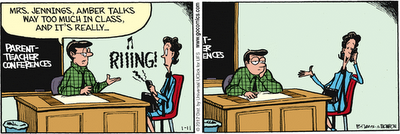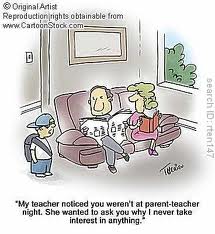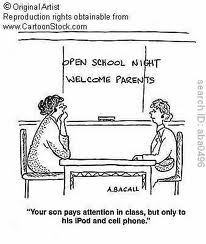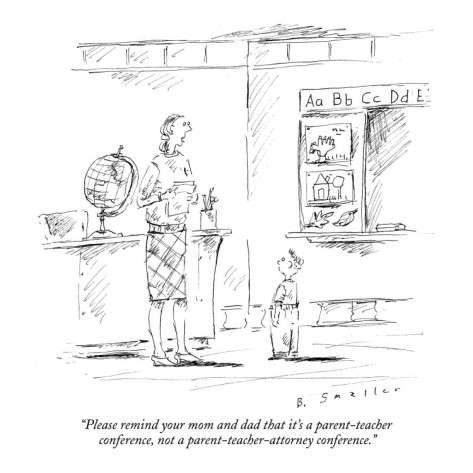Cartoons: Parent-Teacher Conferences
Anyone who has taught for more than a year in the U.S. remembers those formal occasions when the school invites parents to confer with their children’s teachers during an evening or afternoon. In Canada and Australia, they are called “parent-teach interviews”; in UK, they are “parents’ evening.” Afterwards, both teachers and parents can regale their friends with stories of what went right and what went wrong in those conferences.
A few researchers have examined these annual rites. Sara Lightfoot Lawrence, for example, has written of the inherent differences between goals of parents and teachers. Parents are focused on their individual son or daughter while the teacher focuses on the class of 25 sons and daughters. Moreover, she says:
“Mothers seem to be in subtle competition with teachers. There is always an underlying fear that teachers will do a better job than they have done with their child…. But mostly mothers feel that their areas of competence are very much similar to those of the teacher. In fact they feel they know their child better than anyone else and that the teacher doesn’t possess any special field of authority or expertise.”
When Philip Jackson looked at parents and teachers he saw three major differences between the parent-child and teacher-student relationship (p. 29).
1. Emotional ties are stronger between parent and child and last much longer than teacher-student relationships. Of course, this is not to say that in many instances teacher-student relationship can be strong and lasting. Overall, however, the dominant teacher-student relationship is impersonal in classroom compared to family.
2. The intensity of feelings and intimacy that characterize child-family relationships almost never happen in classrooms. Moreover, the extent to which in the family children and parents have been exposed to one another and know one another physically and psychologically–the depth and texture of personal history–seldom occurs in classrooms.
3. A classroom is the place where students learn to take orders from non-family adults. “For the first time in the child’s life, power that has personal consequences for the child … is wielded by a relative stranger.”
Scholars have their views of the centrality of parents and teachers in the lives of children and students. So do cartoonists. For this month, I have selected some cartoons and YouTube videos to illustrate the range of parent-teacher conferences and how they reflect the similarities and differences between the parent-child and teacher-student relationship. (Previous monthly cartoons have been: “Digital Kids in School,” “Testing,” “Blaming Is So American,” “Accountability in Action,” “charter schools,” and “Age-graded schools,” and Students and Teachers).
A New Yorker animated cartoon captures in 22 seconds what some teachers would like to say (but seldom do) about a certain kind of student.
I end with another animated cartoon that lasts nearly five minutes and, for me, was painful to watch.
This blog post has been shared by permission from the author.
Readers wishing to comment on the content are encouraged to do so via the link to the original post.
Find the original post here:
The views expressed by the blogger are not necessarily those of NEPC.






